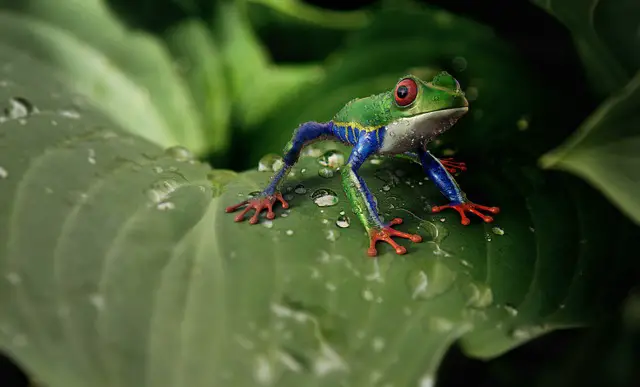Most people know that frogs need water to survive. They live in water, eat in water, and mate in water. So it’s no surprise that many believe frogs cannot live without water. But did you know that several species of frogs can live in and out of water?
This blog post will look closely at some fantastic creatures and learn how they’ve adapted to survive on land and water.
Can frogs live without water?
Frogs are amphibians, meaning they can live both in water and out. Interestingly, certain species of frogs, such as the desert rain frog, can go up to 10 months without water.
These frogs mostly survive on humidity gained from the air to keep themselves hydrated. However, for most other species of frogs, you are not recommended to deprive them of water as this could cause dehydration, which leads to stress and a weakening of the immune system.
Water should always be provided in some form, even if it’s a shallow dish, so your frog can remain healthy and happy.
Species of frogs that can live both in and out of water
The first frog on our list is the African Dwarf Frog.
As its name suggests, this frog is found in Africa and typically lives near bodies of water such as ponds, lakes, and rivers.
African Dwarf Frogs are small frogs; they grow to be about 2-3 inches long and have dark brown or black skin. These frogs are good swimmers and have webbed feet to help them move through the water. African Dwarf Frogs also can absorb oxygen through their skin, which means they can stay submerged for long periods without coming up for air.
While African Dwarf Frogs need water to survive, they can also live out of water for short periods.
If their skin dries out, they will become dehydrated and may die. For this reason, it’s essential to provide African Dwarf Frogs with a humid environment if you keep them as pets.
You can do this by misting their enclosure with water daily or using a reptile fogger to create a humid environment.
Red-Eyed Tree Frog
Another interesting frog that can live in and out of water is the Red-eyed Tree Frog. This frog is found in Central and South America and typically lives in tropical rainforests near bodies of water. Red-eyed Tree Frogs are brightly colored frogs with green skin, red eyes, and orange toes.
These frogs are good climbers and use their long toes to grip tree branches. Red-eyed Tree Frogs also can absorb oxygen through their skin, which means they can stay submerged for long periods without coming up for air.
Like African Dwarf Frogs, Red-eyed Tree Frogs need moisture to survive but can live out of water for short periods.
If their skin dries out, they will become dehydrated and may die.
For this reason, it’s essential to provide Red-eyed Tree Frogs with a humid environment if you keep them as pets. You can do this by misting their enclosure with water daily or using a reptile fogger to create a humid climate.
How is a frog able to live both on land and in water?
A frog’s ability to live on land and in water is an impressive feat of adaptation.
Frogs can survive the wet environments of ponds, lakes, and rivers using the physical traits of webbed toes that act as paddles and eyes that stick out above the water surface, allowing them to see predators approaching from underneath.
While on land, frogs use their hind legs to hop from place to place and even climb if needed. They also have smooth, permeable skin, which allows them to process moisture effectively so they won’t dry out when venturing away from a body of water for food or breeding purposes.
This makes it possible for frogs to inhabit almost any region on Earth – unless conditions are too cold or too arid for their delicate aquatic systems.
Conclusion
Frogs are amphibians, meaning they can live in water and on land. Many species of frogs can live in and out of water; examples include the African Dwarf Frog and the Red-eyed Tree Frog. These frogs have adapted to survive in both land and water by developing the ability to absorb oxygen through their skin. While these frogs need moisture to survive, they can live out of water for short periods if their skin does not dry out completely.




